Teaching Teachers
STREAMing Engineering
An elementary schoolwide endeavor to build young engineers prioritizes training teachers first
Science and Children—October 2019 (Volume 57, Issue 3)
By Lauren Burrow and Chrissy Cross
This column enhances the repertoire of preservice and inservice teachers.
“What does an engineer do?”—the question goes out to a cafeteria filled with elementary students. Hands eagerly shoot up in the air to share responses like: “They build things!” “They design things!” “My uncle is an engineer!” The teachers in the room smile and nod their heads to acknowledge the accuracy of the responses. “Yes, they build and design. They make ideas come to life by inventing new things that may have never existed before. Today, y’all are all going to be engineers. You are going to engineer the inventions your teams have planned in order to solve a problem a character faced in the book we all read earlier this week in our classes.” Excited cheers ring out throughout the room as the teachers signal, “Ready! Set! Go be ENGINEEEEEEEEERS!” The next 45-minutes is a controlled chaos of material swapping, conversations of negotiation and compromise, hands-on building, and excited creation. This is Novel Engineering in action!
Created by Tufts University through an NSF-funded project, the Novel Engineering website explains that “Novel Engineering is an integrated approach to teaching engineering and literacy” (2018) that asks teachers to support students’ engagement in a project-based endeavor of problem-and-solution processes and products. The overarching structure of activities in novel engineering require students to read a novel (children’s picture books or young adult chapter books both work) and engineer a creative solution to a problem described in the novel. In this article, we share how teachers were prepped for the program.
Recognizing the Benefits of Novel Engineering
In 2009 the National Academy of Sciences (NAS) identified academic benefits for including engineering as an integrated part of PK–12 STEM education, including increased future achievement in math and science as well as improved technological literacy (Katehi, Pearson, and Feder 2009). Early exposure to engineering processes and skills increases the likelihood of elementary students pursuing STEM college majors and careers in diverse populations of students (DeJarnette 2012). Additionally, alignment to state standards that could be accomplished across various subject matters throughout the many novel engineering steps can be seen in the alignment to Next Generation Science Standards. When elementary teachers include engineering in the curriculum, students are set up for future success!
Novel engineering hinges on being comfortable with making mistakes, repurposing everyday materials for creative solutions, and not letting the “probable” get in the way of the “possible”—practices that adults often forget/rarely attempt. Limited opportunities to practice “curious wonderment” paired with the fact that most elementary school teachers “fear” science instruction due to very limited science backgrounds during their teacher preparation programs (Haefner and Zembal-Saul 2004) can result in teachers’ wariness to incorporate innovative science activities like novel engineering into the classroom. Therefore, we believe that before students dive into this intelligent, interactive activity, teachers should grab a small group of grade-level peers and try it out for themselves to discover firsthand the productive struggle and creative commitments this interdisciplinary work encourages. Because while research findings indicate that students academically benefit from novel engineering due to the hands-on, immersive experience it creates for science exploration during reading-based lessons, a more unique benefit may be the confidence-building capability these lessons hold for “science-wary” teachers (Johnson, Wendell, and Watkins 2016; Wendell 2014).
In the fall of 2018, three professors were approached by a local elementary school to lead a multiday, schoolwide event that could promote a hands-on STREAM (Science, Technology, Reading, Engineering, Arts, and Mathematics) activity for elementary school–age students. The authors chose to lead an adapted version of Tufts’ Novel Engineering to better fit the specific needs and resources of the local partnering school; they dubbed this version: “Nacogdoches-Style Novel Engineering.” This revised version of Tufts’ original work takes into account that schools across the United States have experienced budget cuts and serve populations of students who are low SES; unlike Tufts’ Novel Engineering, which emphasizes high-tech, workable creations, the professors’ revised emphasis on “process” and low-cost materials took into consideration the realities of the local elementary school’s budget, staffing, and diverse curriculum goals.
We led the elementary school’s teachers (grades K–5), who serve primarily students of low SES in rural East Texas, through a half-day professional development to ease teacher fears, encourage teacher creativity, and promote positive personal experiences so they could better understand how to communicate to their students the merits of making, teamwork, process over product, and trying…learning…trying again within the novel engineering process. The self-efficacy the teachers experienced from the PD was the key to forming the professional expertise that could make possible the excitement described in the opening paragraph. The novel engineering event was such a success, we wanted to share our adapted model with science teachers nationwide, this article will now outline this process-oriented Nacogdoches-Style Novel Engineering for use in teachers classrooms by sharing the step-by-step process (including pre-planning steps), project examples from the PD, and additional author suggestions are also included as resources for quick and easy teacher implementation.
Pre-Step 1: Defining Terms
Before implementing novel engineering with a class or whole school, it is imperative to have an initial discussion about definitions of concepts and practices found throughout the novel engineering activity. Research indicates many students narrowly perceive and define science and engineering and who is doing science and engineering, thus making this discussion essential to reconceptualizing science and engineering learning experiences (Chambers 1983; Knight and Cunningham 2004). This facilitated discussion acts as a common vocabulary of intentional language across classrooms and grade-levels to promote consistent identification of students as “engineers,” “scientists,” “designers,” and so on. Figure 1 offers the definitions that were used for the Nacogdoches-Style Novel Engineering. These definitions were inspired by Tufts’ explanation of “Novel Engineering,” but also include The Science Council’s (2019) expanded definition for “scientist” and recent ISTE keynote speaker Michael Cohen’s (2018) reframed definition of “creativity.”
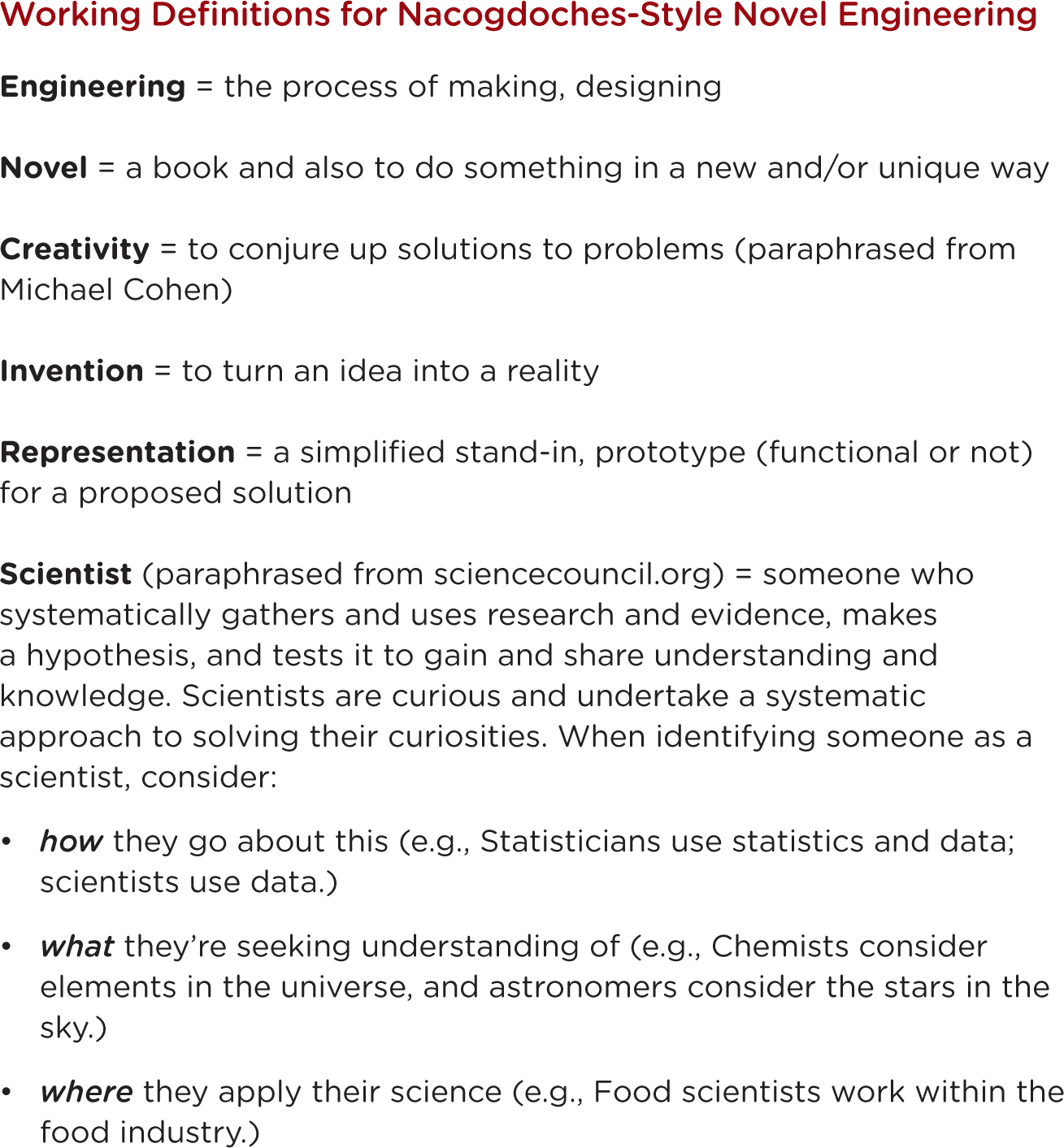
Pre-Step 2: Establishing Goals and Explaining Procedures
With a common language established, teachers next need to explain the goals and procedures of novel engineering to students. A successful novel engineering experience has students identify problems in pre-selected books and then leads to engineering solutions for the book character(s) with emphasis on collaborative work times that focus on solution-making as a result of effective teamwork and a reflective, risk-taking learning process. While Tufts’ Novel Engineering seems to place equal attention on “process” and “product,” we chose to place a greater emphasis on the novel engineering process at the elementary school, so teachers could capitalize on young students’ predispositions to solve problems and design solutions across subject matters as a means of cultivating their identities as creative engineers and inventors. Additionally, an insistence on “workable” solutions can limit student creativity and risk-taking; rather the authors encourage teachers to consider even “non-working” inventions as “successes in solution-making.”
Throughout the steps of novel engineering, teachers facilitate students’ metacognition of STREAM-based principles through in-class discussions, monitoring of a student’s input on the student record sheet that doubles as an assessment artifact (access the record sheet here), and close attention to level of engagement of each of the students participating. While novel engineering has obvious connections to science, technology, and engineering knowledge and skills, the authors remind teachers that the reading and writing-based components of the process are equally important for leading students to successful completion of the engineering experience.
The Steps of Nacogdoches-Style Novel Engineering
The Tufts-created Novel Engineering process is comprised of three overarching steps, but we offer an adapted version, which we designed to fit the specific needs of our partner elementary school (presented in Figure 2). Schools/teachers are encouraged to revise either version before embarking on their own novel engineering experience.
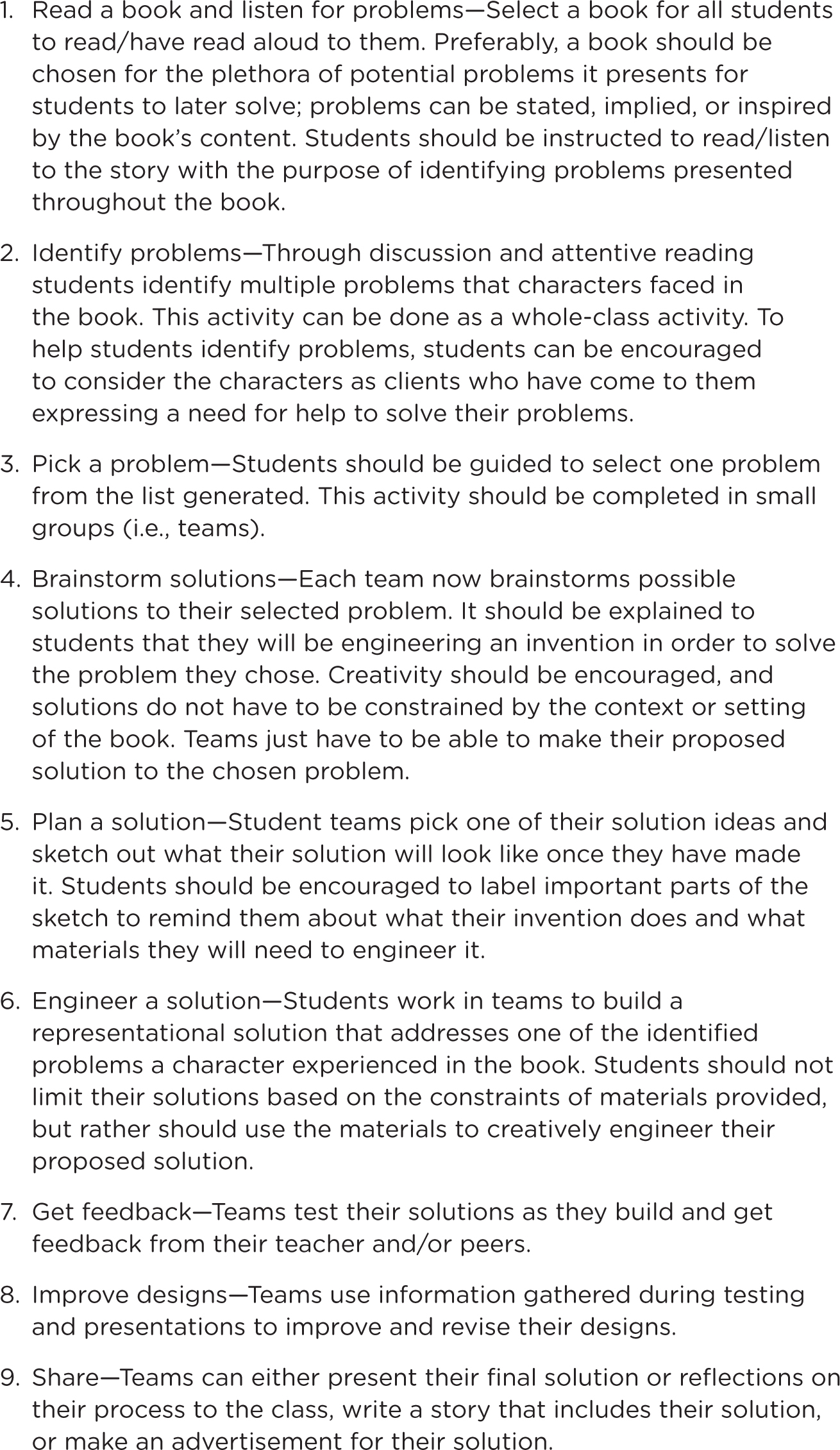
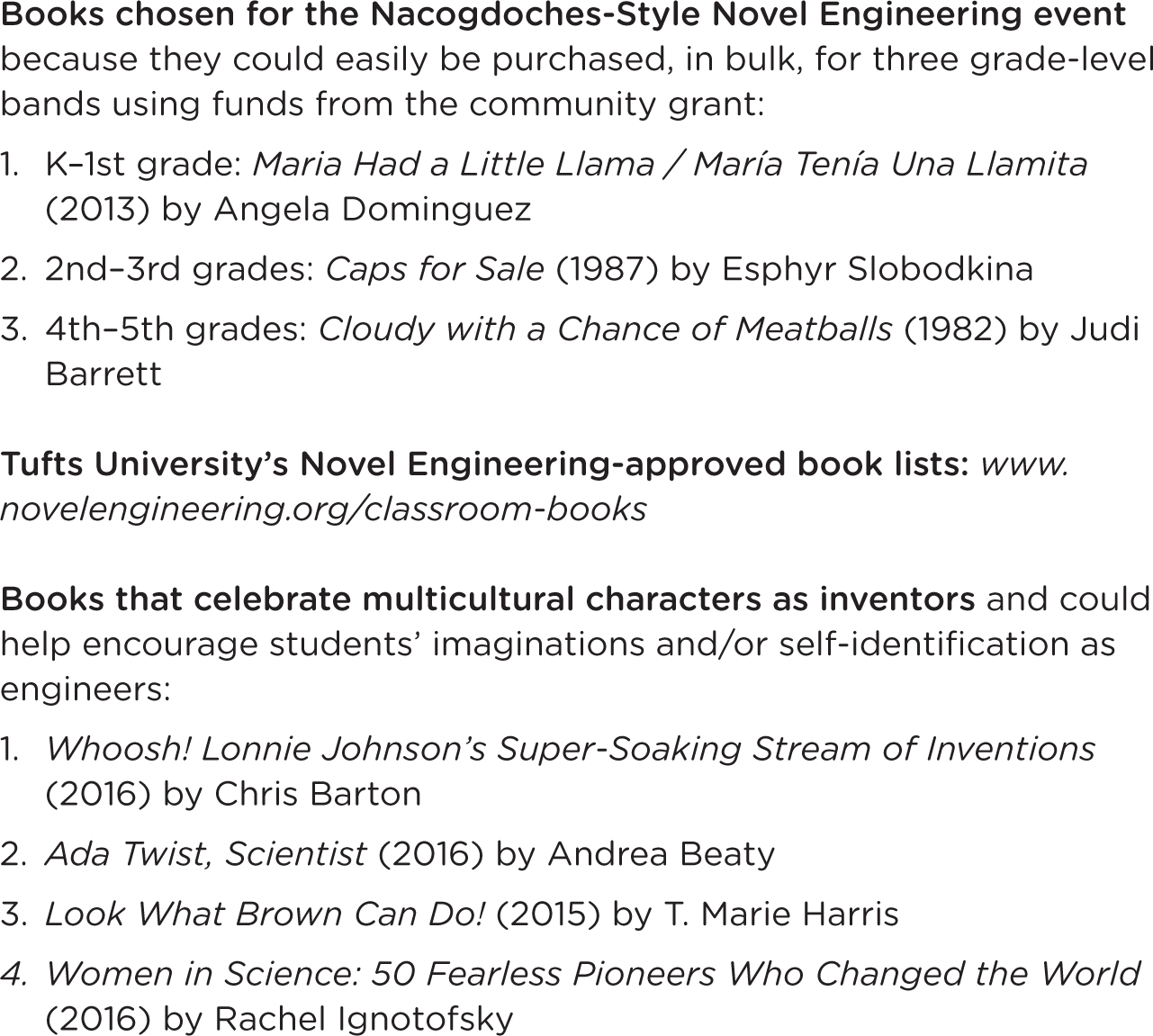
Marvelous Cornelius: Hurricane Katrina and the Spirit of New Orleans by Phil Bildner and John Parra (2015) will be used throughout this article as an example of a culturally responsive text for use with novel engineering. This book, which is appropriate for grades K–2, is an inspired chronicling of the heroic acts of an African American garbage collector in the aftermath of Hurricane Katrina in New Orleans. It presents problems like: How can one man clean up a city? How can a city prevent future hurricane destruction? and other issues related to environment, weather, and waste.
Steps 2–4: Problems and solutions. Teams should complete Steps 2–4 (see Figure 2) by discussing problems—stated and implied—that characters need help solving (see Figures 4 and 5 for teacher examples connected to Marvelous Cornelius). During these steps, the teacher can lead whole-class or small-group discussions by asking questions of the students about what problems need to be solved.
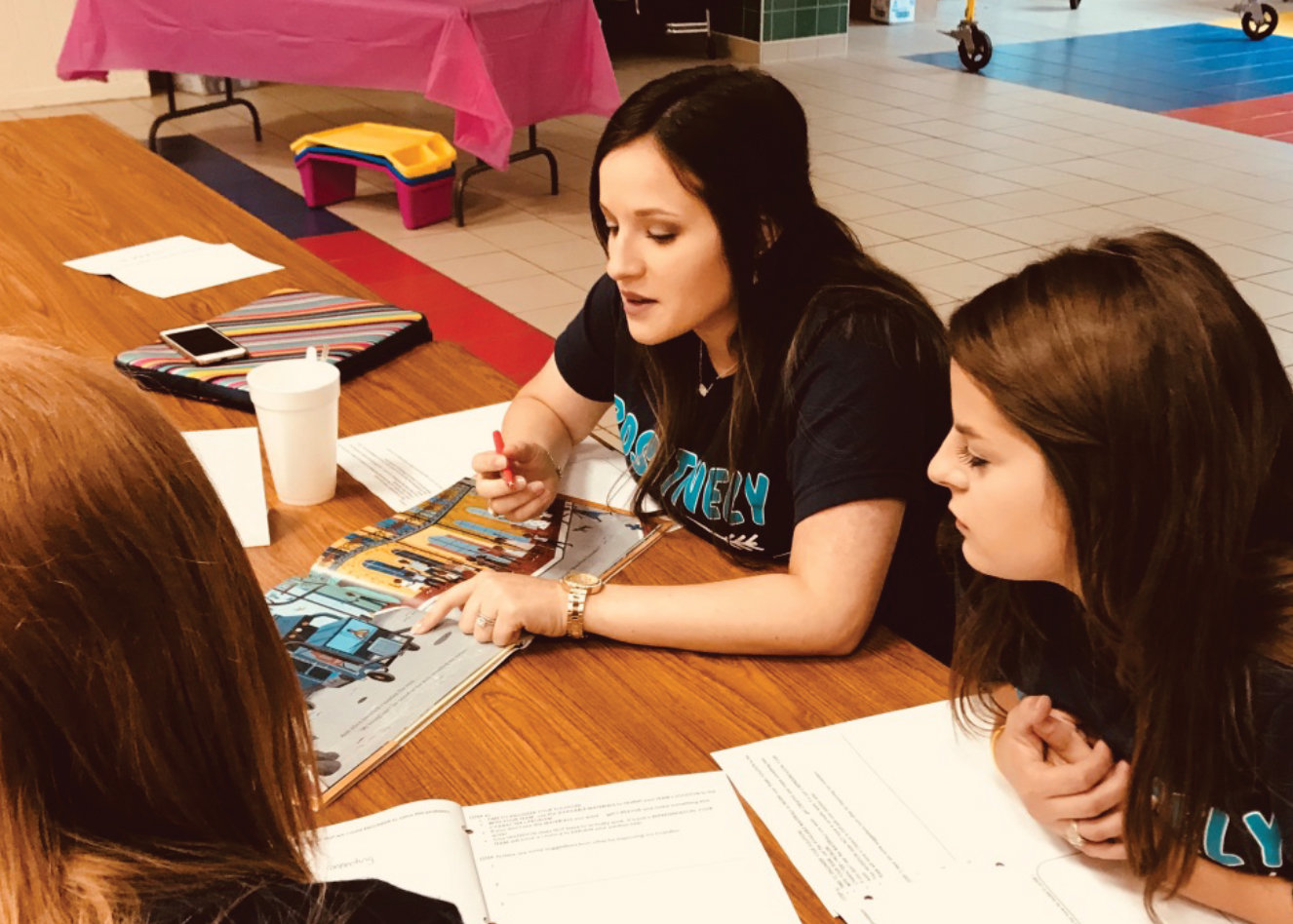
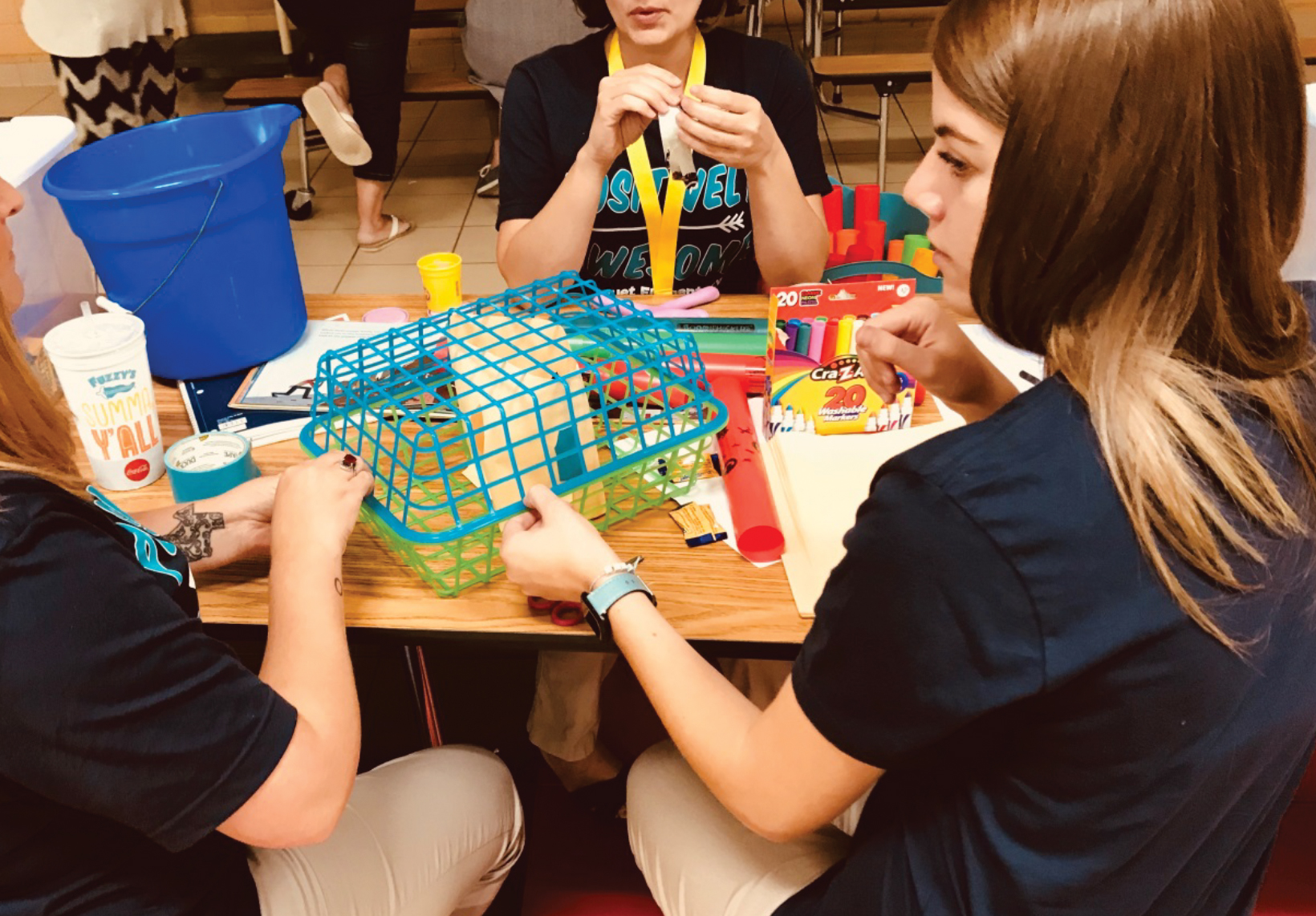
Steps 5 and 6: Making requires “marvelous minds,” not costly materials. Before students begin invention planning (Step 5, Figure 2), sharing a news clip like (2012), about a young boy who engineered a working arcade out of common household items or reading This Is Not a Stick by Antoinette Poris (2007) can activate the “marvelous minds” of young students to encourage imaginative inventing. Both the news clip and the book tell stories about creative kids who took common items and used them to create objects and inventions that may not be obvious at first glance; teachers can facilitate conversations about the imagination at play in either/both models and encourage students to reconsider everyday objects’ uses and potential as a means of sparking their ingenuity.
When teams are ready to translate ideas into inventions (Step 6, Figure 2), teachers should keep in mind that this revised version of novel engineering does not have to be a costly endeavor because the emphasis on “process” means that everyday items are sufficient. A collection of donated materials from the community can connect students’ families to in-class projects, while charging students with a “resource scavenger hunt” in the classroom could become a lesson in conservation, recycling, and repurposing. Keep in mind, providing basic tools (e.g., tape and scissors) to every group can help shorten “build times,” while withholding basic tools can require students to use complex problem-solving skills to adapt. The authors always recommend that teachers do a “safety check” of any donated/found items before allowing students to engineer with them. Keep an eye out for any hazards such as sharp edges and germs, and consider the suitability of the material for use by younger-age children.
The initial build time (Step 6, Figure 2), where teacher intervention should be limited to safety checks and minimal prompting of on-task behavior, should last for approximately 15–45 minutes, based on students’ ages and complexity of planned inventions. Materials can be distributed evenly for team use or teachers can designate students to collect materials based on teams’ needs. This first build time should emphasize student collaboration and encourage trial-and-error attempts as group members work together with provided materials. Teachers can use phrases to encourage students to work together by watching participation level of each student in each group and by saying, “Student name, what do you think about the design?” or “Student name, if you could change anything about the design what would you change?”
Steps 7 and 8: Engineering time. After initial build time, teams should present their draft inventions to other teams for critical feedback on design improvement, based in scientific and engineering principles (Step 7, Figure 2). Teachers could revisit previously studied science lessons to help guide students’ designs to become more efficient or practical. During the final build time (Step 8, Figure 2), students should be encouraged to alter at least one element of their original design—based either on directed peer feedback or new thoughts generated from the team-to-team discussions. Figure 5 shows an example of how incorporating another team’s suggestion of adding simple machines helped make an original invention “safer” for the book characters to use. Teachers can guide student feedback by using phrases that encourage students to think hypothetically about their designs, such as, “What would happen if it was rainy when this design was used?” or “Would this design work if one hundred people needed to use it?” Some of the inventions inspired by Marvelous Cornelius were a giant trash suction machine, tiny trash collecting robots, and a machine that recycled the trash into energy.
Step 9: Student reflection and teacher assessment. After final build time, teams complete write-ups to share out summaries of their inventions and to explain how their solutions addressed identified problems (Step 9, Figure 2). Overall, while emphasis on “engineering time” should be given the most attention—as this is the most engaging steps for students and will probably act as the catalyst for future pursuits of STREAM-related skills and knowledge acquisition—the feedback, write-up, and sharing of the steps allows students to document and publicly communicate what learning actually took place throughout the experience (Figure 6).
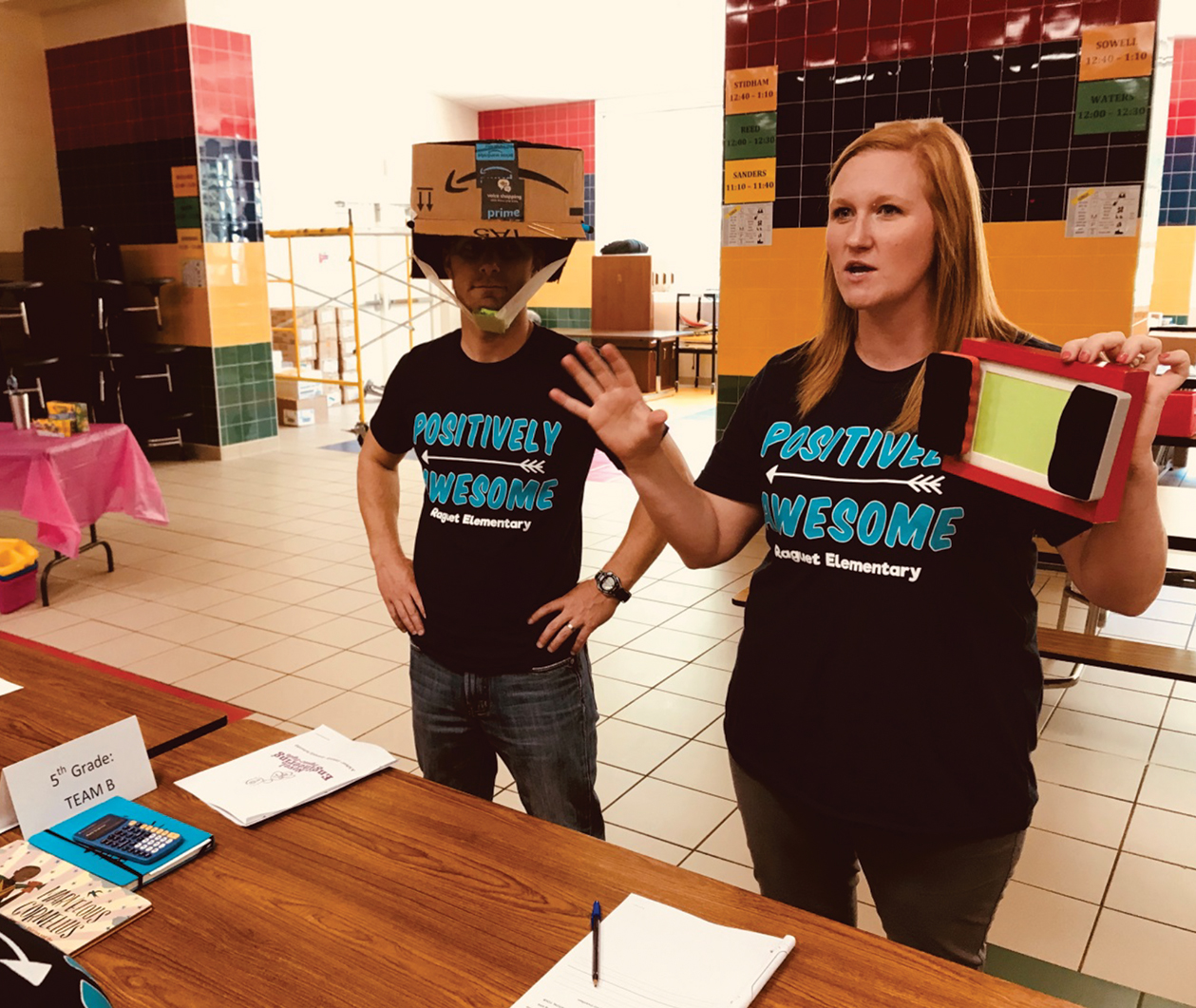
Recommendations for Success
Novel engineering is a STREAM-experience that can easily be modified to welcome the youngest engineers or challenge older science students; it is an engaging endeavor that is appropriate for classroom study or school-wide competition. Here are some recommendations for a more successful learning experience: 1.Effective group management should be practiced before undertaking this project. Inadequate preparation for successful teamwork will most likely lead to student team members attempting to engineer individual inventions rather than engaging in collaborative problem-solving and mutual solution-making. Teachers can promote effective group management by making sure all supplies are easily procured by the students and walking around to monitor the teamwork and participation within the small groups. 2.The “feedback step” can be difficult for young students to effectively execute if they are not familiar with how to give/receive feedback that is meant to improve inventions, not “hurt feelings.” Ask students to frame their feedback using the following sentence-starters: “I like _________ about your invention, because _____________. Do you want to consider adding _____________ / changing _______________ /trying _________________?” 3.Consider saving the “sharing stage” for another day to give teams a chance to reflect on what they actually accomplished. Technology-based story apps such as HaikuDeck (limited trial free), Shadow Puppet Edu (free), or iMovie (free) can help emergent writers share their solutions beyond the limitations of their current writing abilities or challenge older students to consider the ways in which media-based embellishments could help others “relive” the excitement they experienced during the project. Be sure to do a common sense check regarding student privacy and check sharing options if opting to add story apps. 4.If you choose to pursue a school-wide event, enlisting adult volunteers can help keep “work spaces” clean, encourage productive teamwork, and act as “safety monitors” as students work with a variety of materials. If your school is located near a university, reach out to education, science, or engineering course instructors who may be willing to offer student volunteers who need to complete hours toward their degree credit. Always consult with your district’s volunteer policies before inviting external volunteers to campus.
We hope this article helps teachers adapt and implement novel engineering at their own school. This activity could be used for grade-level competitions/individual class projects, or promote interdisciplinary partnerships between literacy and science educators or schools and local universities. Emphasis on the reading-based components and hands-on experience with novel engineering can help make scientific exploration more relevant and accessible to the many elementary school teachers who might currently “fear” science instruction so that they, in turn, can help their students realize the benefits of becoming a “novel engineer.”
Acknowledgment
Funding for this event was provided by a local community grant from Nibco, Inc.
Engineering Preservice Science Education Early Childhood Elementary


